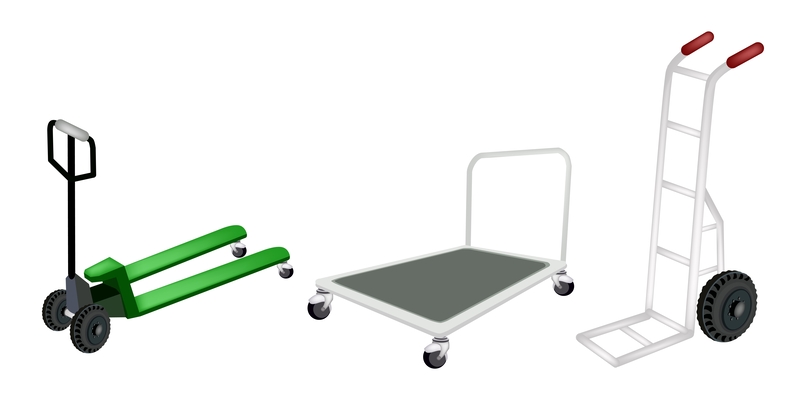Expert Advice on Moving Your Bed and Mattress
Posted on 25/05/2025
Expert Advice on Moving Your Bed and Mattress: A Complete Guide
Moving your bed and mattress can be one of the most daunting tasks during a relocation. Due to their size, weight, and importance for comfortable sleep, it's crucial to handle these items with care. Whether you're relocating across town or to a different state, there are proven strategies you can use to make the process efficient, safe, and hassle-free.
In this comprehensive guide, our moving experts walk you through every step: from prepping your bed frame and mattress, to transporting them, and reassembling in your new home. Let's dive into the details and ensure your move is smooth and your bed arrives in perfect condition.

Why Proper Bed and Mattress Moving Matters
Your bed and mattress are vital for your rest and well-being. Poor handling during bed or mattress moving can result in damage, lost parts, and a decrease in comfort and hygiene. Most beds, especially memory foam or hybrid mattresses, require careful handling to maintain their structure and cleanliness.
- Prevent Damage: Avoid bent frames, torn fabric, or compromised mattress support.
- Ensure Hygiene: Beds and mattresses easily collect dust and debris during moves.
- Save Money: Proper packing and transportation reduce the risk of needing costly repairs or replacements.
Step-by-Step Instructions for Moving a Bed and Mattress
1. Gather All the Necessary Tools and Materials
- Mattress bag (waterproof, tear-resistant)
- Furniture sliders or moving blankets
- Screwdriver or Allen wrench
- Plastic bags for screws and small parts
- Stretch wrap and/or bubble wrap
- Packing tape (strong and wide)
- Moving straps or ropes
- Dolly or hand truck
Preparation is key for an efficient bed and mattress move. Before you attempt to lift or disassemble anything, ensure you have all required supplies. Using the right tools prevents injuries and damage.
2. Clean and Prepare the Mattress
Dust, mites, and allergens tend to accumulate in beds over time. Begin by stripping the bed of all bedding and pillows. Launder them separately. Next, vacuum both sides of the mattress using an upholstery tool. For a deeper clean, lightly sprinkle the surface with baking soda and let it sit for 30 minutes before vacuuming again.
- Let your mattress air out for a few hours before encasing it.
3. Disassemble the Bed Frame
Unless you're moving a simple platform bed, you'll need to disassemble your bed frame. Refer to your manufacturer's instructions if needed. Start by removing slats, headboard, and footboard. Place all bolts, nuts, and small parts in labeled sealable plastic bags. Tape the bags to the largest frame part to avoid losing them.
- Tip: Take pictures of the assembly process--these will help during reassembly.
4. Protect the Mattress and Bed Frame
For the mattress, slide it into a heavy-duty mattress bag and seal tightly. This shields it from moisture and dirt during the move. If you don't have a mattress bag, wrap thoroughly with stretch wrap and secure with tape.
For the frame, use moving blankets or bubble wrap to pad wood or metal components. Secure everything with packing tape or stretch wrap to prevent scratches or cracks during transport.
5. Safe Mattress and Bed Transport Techniques
Moving a mattress--especially a king or queen size--requires a strategy due to its awkward size and flexibility. Team lifts are always safer. For frames, keep components bundled to reduce the number of trips.
- Use a dolly or hand truck for particularly heavy frames or dense mattresses
- Slide the mattress (vertically on its side) through doorways and hallways to prevent getting stuck
- Bend at your knees and keep your back straight when lifting
- Lift with a partner whenever possible to avoid strain
6. Loading the Bed and Mattress into the Moving Vehicle
When loading your mattress and frame, always place the mattress flat in the vehicle, not on its side--especially for memory foam or hybrid models, which may deform if compressed sideways. Lay it atop other soft, clean items like bedding or pillows if possible.
For bed frames, stack slats and rails together and secure them with rope or moving straps to avoid shifting during transport.
DIY vs. Professional Moving: Which Is Best for Beds and Mattresses?
When to Move Your Bed and Mattress Yourself
- You're moving locally and have access to a roomy vehicle, like a van or moving truck.
- You have help from friends or family for heavy lifting.
- You have gentle confidence in disassembling and reassembling furniture.
When to Hire Moving Professionals
- You own a large bed (king, queen), adjustable base, or high-end mattress.
- Your bed frame is delicate, expensive, or antique.
- You're moving long-distance or have multiple flights of stairs.
- You prefer to guarantee safe transport with insurance options.
Experienced movers not only supply the proper packing and lifting equipment, but they are also trained to navigate tight spaces and awkward angles--often without damaging walls or the bed itself. If your goal is truly risk-free bed and mattress transport, investing in professionals is wise.
Common Mistakes to Avoid When Moving Your Bed and Mattress
Even when you're careful, certain oversights can lead to costly errors when moving your mattress or bed frame. Here are the most common pitfalls--and how to avoid them:
- Skipping Mattress Protection: Never move a mattress without encasing it; exposure leads to stains and odors.
- Forgetting to Label Parts: Small connectors or screws can easily go missing, making reassembly frustrating.
- Improper Lifting: Dragging or heaving a mattress causes tears and can injure your back.
- Transporting Unsecured: Unfastened bed parts can slide and break during the move.
- Bending a Foam Mattress for Too Long: Prolonged bending can permanently damage structure and comfort.
Special Tips for Different Types of Mattresses
Moving Memory Foam and Latex Mattresses
These mattresses are flexible but heavy. Carry them upright on their side to maneuver stairs and corners, but never fold them further than a soft C-shape for more than a few minutes. Compression and creasing during a move can harm their comfort and support.
Transporting Innerspring Mattresses
Innerspring models are more rigid but lighter than foam. Still, never fold or bend an innerspring to fit into a small space. Doing so can cause permanent wire damage, leading to uncomfortable ridges or springs poking through.
Hybrid or Pillow Top Mattress
Treat these as a mix of innerspring and memory foam: do not bend, keep lateral and flat during transit, and avoid stacking heavy items on top.
Ensuring Mattress Hygiene During the Move
Mattresses are susceptible to contamination during a move. Here are some expert mattress moving tips to keep your bed as clean as possible:
- Double-bag or double-wrap the mattress for extra barrier protection.
- Wipe down the frame before packing away dust and allergens.
- Store or transport the mattress above other items in the truck so nothing dirty comes into contact with it.
- Allow the mattress to "breathe" for several hours after unwrapping before making the bed in your new home.
How to Reassemble Your Bed After the Move
At your new place, unpack and inspect all components for any signs of damage. Organize all screws, bolts, and support slats before starting. Refer to your phone's photos for step-by-step reference or consult the assembly manual.
- Lay out all frame parts near the bed's new location.
- Assemble the frame carefully, double-checking connections and stability.
- Place the mattress and check for deformities (especially corners or edges).
- Install fresh bedding and pillows for the best sleep in your new home.
*If your mattress exhibits any unusual lumps, sagging, or tears after the move, contact your manufacturer or moving company about warranty or insurance options.*

Expert Moving Advice: Additional Tips & FAQs
How do I move a bed and mattress by myself?
If you must move a bed and mattress solo, prepare the path by moving obstacles, use sliders or a dolly, and wrap the mattress well. Take your time and avoid lifting weights beyond your comfort--consider disassembling as much as possible to reduce weight per load.
What is the best way to transport a mattress?
Transport your mattress flat, either in a truck bed or van, inside a sealed protective cover. Never strap the mattress to the roof of your vehicle--this can cause it to fly off or become deformed.
Can I fold or bend my mattress?
While some foam mattresses can tolerate mild bending for short spans, most beds should never be folded. Always check your manufacturer's guidelines before attempting.
How do I move my bed into a new apartment with tight stairwells?
Measure all doorways and stairs before moving. Consider partial disassembly, and use strong helpers to angle pieces gently through tight spots. If required, hire experienced movers who specialize in furniture navigation.
Should I replace my mattress when I move?
If your mattress is over 7-10 years old, shows signs of wear, or has lost its comfort, relocation is an excellent time to upgrade. Many mattress retailers even offer set-up and disposal services for a seamless move.
Conclusion: Move Your Bed and Mattress Like a Pro
With a bit of planning and the expert tips outlined here, moving your bed and mattress doesn't have to be a stressful or physically demanding ordeal. Prioritize protection, follow proper lifting techniques, and don't hesitate to call in professionals if you have doubts. Your restful sleep is worth the extra care!
For more moving tips and mattress care advice, bookmark our site and share these expert strategies with anyone preparing for an upcoming move.



